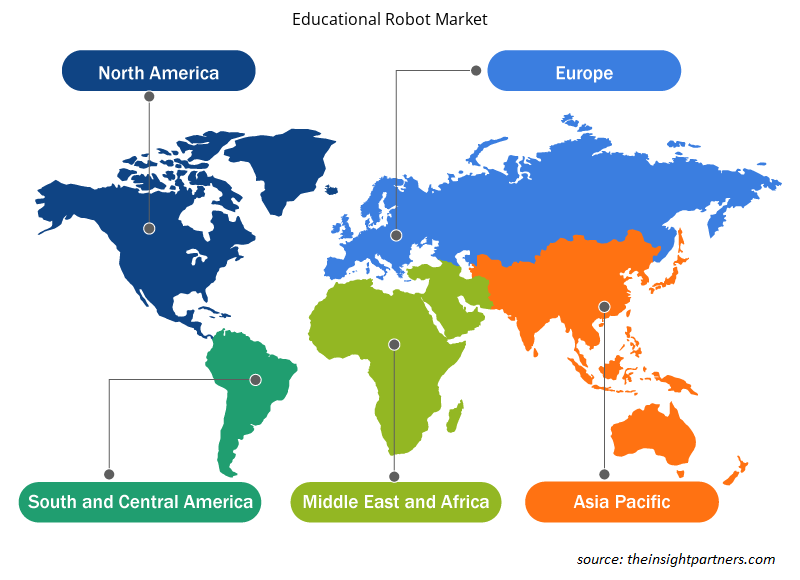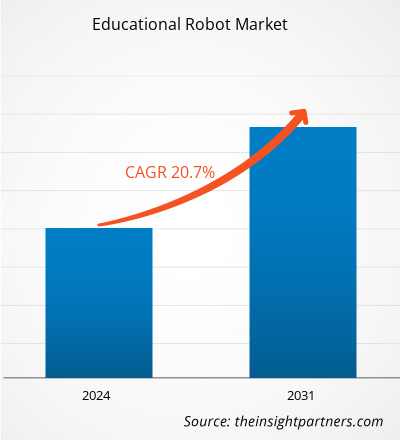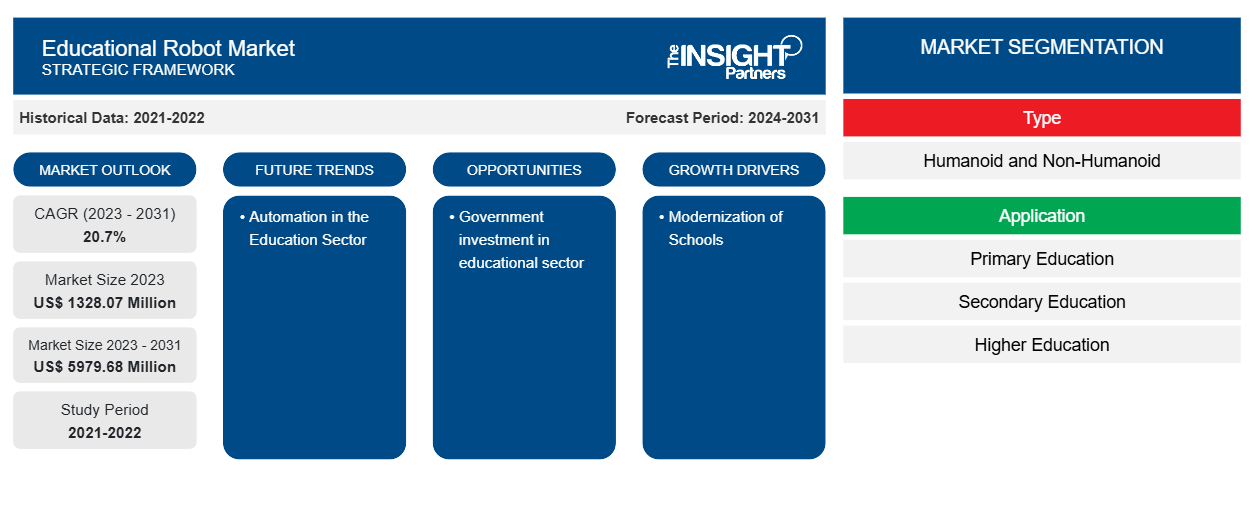من المتوقع أن يصل سوق الروبوتات التعليمية إلى 5979.68 مليون دولار أمريكي بحلول عام 2031 من 1328.07 مليون دولار أمريكي في عام 2023. ومن المتوقع أن يسجل السوق معدل نمو سنوي مركب بنسبة 20.7٪ خلال الفترة 2023-2031. ومن المرجح أن يظل الاستثمار الحكومي في الروبوتات والأتمتة في قطاع التعليم من الاتجاهات الرئيسية في السوق.
تحليل سوق الروبوتات التعليمية
إن التركيز المتزايد على تعزيز العلوم والتكنولوجيا والهندسة والرياضيات (STEM) هو المحرك لنمو السوق. كما تعمل الاستثمارات في النظام التعليمي من قبل السلطات الحكومية على تعزيز نمو السوق. كما تقوم المدارس والكليات بتضمين جوانب مختلفة من الروبوتات مما يدفع نمو السوق.
نظرة عامة على سوق الروبوتات التعليمية
الروبوتات التعليمية هي روبوتات قابلة للبرمجة تمكن الطلاب من جميع الأعمار من تعميق معرفتهم بالروبوتات والبرمجة. بالإضافة إلى ذلك، فهي تساعدهم على تعلم مهارات معرفية أخرى. فهي توفر للطلاب كل ما يحتاجون إليه لبناء وبرمجة روبوت يمكنه أداء مجموعة متنوعة من المهام.
قم بتخصيص هذا التقرير ليناسب متطلباتك
ستحصل على تخصيص لأي تقرير - مجانًا - بما في ذلك أجزاء من هذا التقرير، أو تحليل على مستوى الدولة، وحزمة بيانات Excel، بالإضافة إلى الاستفادة من العروض والخصومات الرائعة للشركات الناشئة والجامعات
-
احصل على أهم اتجاهات السوق الرئيسية لهذا التقرير.ستتضمن هذه العينة المجانية تحليلاً للبيانات، بدءًا من اتجاهات السوق وحتى التقديرات والتوقعات.
محركات وفرص سوق الروبوتات التعليمية
تحديث المدارس
تستثمر الحكومة بشكل كبير في قطاع التعليم لتحديث المدارس والكليات وتعزيز تعلم الطلاب بشكل أكبر. تشجع هذه الاستثمارات اللاعبين في السوق على توفير الروبوتات التعليمية الخاصة بهم في المدارس، وهو ما يدفع نمو السوق. على سبيل المثال، في أبريل 2022، قالت شركة Shape Robotics الدنماركية إنها وقعت اتفاقية مع شركة KUBO Robots المحلية لتوزيع الروبوتات التعليمية على المدارس في رومانيا.
الأتمتة في قطاع التعليم
كشفت دراسة استقصائية عالمية أجرتها شركة ABB عام 2023 على 2301 متخصص في التعليم أن 80% يعتقدون أن الروبوتات والأتمتة ستشكل مستقبل التوظيف على مدى السنوات العشر القادمة. استخدام الروبوتات في النظام التعليمي وبرامج التدريس. يركز لاعبو سوق الروبوتات الصناعية على إطلاق الروبوتات في قطاع التعليم والتي يمكن أن تغذي سوق الروبوتات التعليمية في المستقبل.
تقرير تحليل تجزئة سوق الروبوتات التعليمية
إن القطاعات الرئيسية التي ساهمت في استخلاص تحليل سوق الروبوت التعليمي هي النوع والتطبيق.
- بناءً على النوع، يتم تقسيم سوق الروبوتات التعليمية إلى روبوتات بشرية وغير بشرية. احتلت الروبوتات غير البشرية الحصة الأكبر من السوق في عام 2023.
- من حيث التطبيق، تم تقسيم السوق إلى التعليم الابتدائي والتعليم الثانوي والتعليم العالي وغيرها. وقد احتلت الشريحة الأخرى حصة كبيرة من السوق في عام 2023.
تحليل حصة سوق الروبوتات التعليمية حسب المنطقة الجغرافية
ينقسم النطاق الجغرافي لتقرير سوق الروبوت التعليمي بشكل أساسي إلى خمس مناطق: أمريكا الشمالية، ومنطقة آسيا والمحيط الهادئ، وأوروبا، والشرق الأوسط وأفريقيا، وأمريكا الجنوبية والوسطى.
من المتوقع أن تنمو منطقة آسيا والمحيط الهادئ بأعلى معدل نمو سنوي مركب خلال فترة التوقعات. تركز المنطقة على التقدم التكنولوجي في القطاع التعليمي. ويكمل الاستثمار المتزايد في القطاع التعليمي نمو السوق. كما أن إدخال الروبوتات في المدارس يدفع نمو السوق في المنطقة. على سبيل المثال، في مارس 2024، قدمت مدرسة في ولاية كيرالا أول مدرس ذكاء اصطناعي في البلاد، Iris، لاتخاذ خطوة مبتكرة نحو التعليم. تم إنشاء Iris بالشراكة مع Makerlabs Edutech وهو أول مدرس روبوت بشري في الولاية وربما في البلاد. Iris قادر على الإجابة على الاستفسارات المعقدة عبر مواضيع مختلفة، وتقديم دعم صوتي فردي، وتعزيز الفرص التعليمية التفاعلية. بالإضافة إلى ذلك، تم تجهيز Iris بعجلات لزيادة القدرة على الحركة.
رؤى إقليمية حول سوق الروبوتات التعليمية
لقد قام المحللون في Insight Partners بشرح الاتجاهات والعوامل الإقليمية المؤثرة على سوق الروبوتات التعليمية طوال فترة التوقعات بشكل شامل. يناقش هذا القسم أيضًا قطاعات سوق الروبوتات التعليمية والجغرافيا في جميع أنحاء أمريكا الشمالية وأوروبا ومنطقة آسيا والمحيط الهادئ والشرق الأوسط وأفريقيا وأمريكا الجنوبية والوسطى.

- احصل على البيانات الإقليمية المحددة لسوق الروبوتات التعليمية
نطاق تقرير سوق الروبوتات التعليمية
| سمة التقرير | تفاصيل |
|---|---|
| حجم السوق في عام 2023 | 1328.07 مليون دولار أمريكي |
| حجم السوق بحلول عام 2031 | 5979.68 مليون دولار أمريكي |
| معدل النمو السنوي المركب العالمي (2023 - 2031) | 20.7% |
| البيانات التاريخية | 2021-2022 |
| فترة التنبؤ | 2024-2031 |
| القطاعات المغطاة |
حسب النوع
|
| المناطق والدول المغطاة |
أمريكا الشمالية
|
| قادة السوق وملفات تعريف الشركات الرئيسية |
|
كثافة اللاعبين في سوق الروبوتات التعليمية: فهم تأثيرها على ديناميكيات الأعمال
يشهد سوق الروبوتات التعليمية نموًا سريعًا، مدفوعًا بالطلب المتزايد من المستخدم النهائي بسبب عوامل مثل تفضيلات المستهلكين المتطورة والتقدم التكنولوجي والوعي المتزايد بفوائد المنتج. ومع ارتفاع الطلب، تعمل الشركات على توسيع عروضها والابتكار لتلبية احتياجات المستهلكين والاستفادة من الاتجاهات الناشئة، مما يؤدي إلى زيادة نمو السوق.
تشير كثافة اللاعبين في السوق إلى توزيع الشركات أو المؤسسات العاملة في سوق أو صناعة معينة. وهي تشير إلى عدد المنافسين (اللاعبين في السوق) الموجودين في مساحة سوق معينة نسبة إلى حجمها أو قيمتها السوقية الإجمالية.
الشركات الرئيسية العاملة في سوق الروبوت التعليمي هي:
- ايسوي روبوتيكس
- شركة هانسون للروبوتات المحدودة
- الروبوتات المعيارية
- روبوتات بال
- شركة فانوك أمريكا
- شركة سانبوت للابتكار التكنولوجي المحدودة
إخلاء المسؤولية : الشركات المذكورة أعلاه ليست مرتبة بأي ترتيب معين.

- احصل على نظرة عامة على أهم اللاعبين الرئيسيين في سوق الروبوتات التعليمية
أخبار سوق الروبوتات التعليمية والتطورات الأخيرة
يتم تقييم سوق الروبوتات التعليمية من خلال جمع البيانات النوعية والكمية بعد البحث الأولي والثانوي، والتي تتضمن منشورات الشركات المهمة وبيانات الجمعيات وقواعد البيانات. فيما يلي بعض التطورات في سوق الروبوتات التعليمية:
- وسعت شركة ABB Robotics نطاق عروضها التعليمية بإطلاق IRB 1090. تم تصميم روبوت التعليم الصناعي 1090، الذي تم اعتماده من قبل معهد التعليم المعترف به عالميًا STEM.org، لرفع مهارات الطلاب وتزويدهم بميزة تنافسية في تأمين فرص العمل. يشكل روبوت التعليم الجديد جزءًا رئيسيًا من عروض ABB التعليمية الأوسع نطاقًا، والتي تشمل روبوتات صناعية إضافية، بالإضافة إلى حزم تعليمية، ووحدات تحكم من الجيل التالي، وبرامج برمجة ومحاكاة رائدة في السوق. (المصدر: ABB Robotics، بيان صحفي، سبتمبر 2023)
- أطلقت شركة ماتاتا ستوديو، وهي شركة تقدم حلول التعلم الرقمي مع الابتكار والأصالة في جوهرها، مجموعة روبوتات تعليمية جديدة تسمى "فينشي بوت"، بهدف الجمع بين علوم الكمبيوتر والذكاء الاصطناعي والتعليم بشكل ترفيهي. يتم تقديم مفاهيم عالية التقنية مثل (الذكاء الاصطناعي) والتعلم الآلي (ML) في الفصول الدراسية في المدارس الابتدائية. لا تعد مجموعات الروبوتات هذه تعليمية للغاية فحسب، بل تتضمن أيضًا البرمجة والتفكير الحسابي والإبداع والاستكشاف. يتمثل مفهوم تصميم ماتاتا ستوديو في تشجيع الأطفال على إتقان المعرفة الأساسية للبرمجة وعلوم الكمبيوتر من خلال بناء وتشغيل الروبوتات بأيديهم مع تنمية تفكيرهم الإبداعي وقدراتهم على حل المشكلات. (المصدر: ماتاتا ستوديو، بيان صحفي، فبراير 2024)
تقرير سوق الروبوتات التعليمية والتغطية والمخرجات
يوفر تقرير "حجم سوق الروبوتات التعليمية والتوقعات (2021-2031)" تحليلاً مفصلاً للسوق يغطي المجالات التالية:
- حجم سوق الروبوتات التعليمية وتوقعاتها على المستويات العالمية والإقليمية والوطنية لجميع قطاعات السوق الرئيسية التي يغطيها النطاق
- اتجاهات سوق الروبوتات التعليمية، بالإضافة إلى ديناميكيات السوق مثل المحركات والقيود والفرص الرئيسية
- تحليل مفصل لقوى PEST/Porter الخمس وSWOT
- تحليل سوق الروبوتات التعليمية يغطي اتجاهات السوق الرئيسية والإطار العالمي والإقليمي واللاعبين الرئيسيين واللوائح والتطورات الأخيرة في السوق
- تحليل المشهد الصناعي والمنافسة الذي يغطي تركيز السوق، وتحليل خريطة الحرارة، واللاعبين البارزين، والتطورات الأخيرة في سوق الروبوتات التعليمية
- ملفات تعريف الشركة التفصيلية
- التحليل التاريخي (سنتان)، سنة الأساس، التوقعات (7 سنوات) مع معدل النمو السنوي المركب
- تحليل PEST و SWOT
- حجم السوق والقيمة / الحجم - عالمي، إقليمي، بلد
- الصناعة والمنافسة
- مجموعة بيانات إكسل
التقارير الحديثة
تقارير ذات صلة
شهادات العملاء
سبب الشراء
- اتخاذ قرارات مدروسة
- فهم ديناميكيات السوق
- تحليل المنافسة
- رؤى العملاء
- توقعات السوق
- تخفيف المخاطر
- التخطيط الاستراتيجي
- مبررات الاستثمار
- تحديد الأسواق الناشئة
- تحسين استراتيجيات التسويق
- تعزيز الكفاءة التشغيلية
- مواكبة التوجهات التنظيمية























 احصل على عينة مجانية ل - سوق الروبوتات التعليمية
احصل على عينة مجانية ل - سوق الروبوتات التعليمية